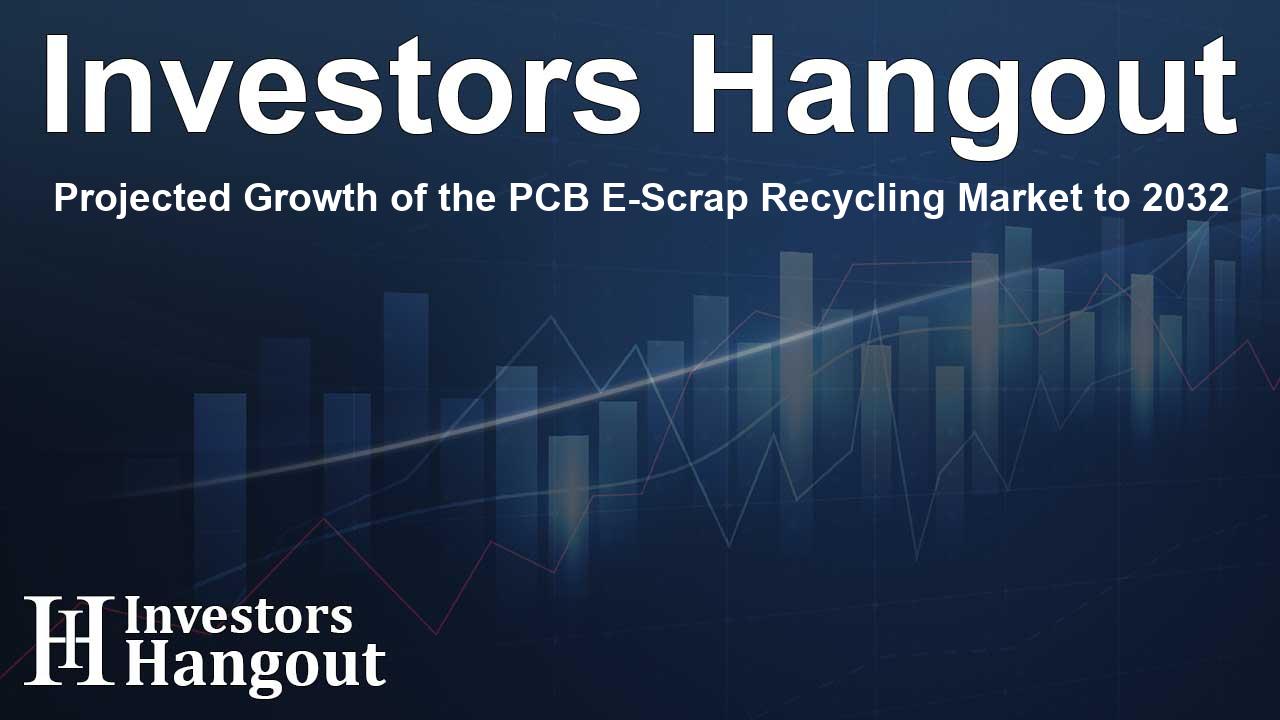Projected Growth of the PCB E-Scrap Recycling Market to 2032

Insights into the PCB E-Scrap Recycling Market Expansion
Austin has become a notable player in the growing landscape of the PCB e-scrap recycling market. According to a recent report, the market, valued at USD 699.43 million in 2024, is projected to hit USD 1371.12 million by 2032, showcasing a remarkable annual growth rate (CAGR) of 8.78% through the forecast period.
Factors Fueling Market Growth
The rapid increase in electronic waste, combined with the urgent need for sustainable waste management practices, has sparked significant growth in PCB recycling. This upward trend is particularly pronounced in the Asia-Pacific region, which is seeing advancements in manufacturing and recycling infrastructure. Innovative technologies such as hydrometallurgy and biotechnology are opening new doors for the recovery of valuable metals, aligning with goals for a circular economy. However, the journey is not without its hurdles, including high facility costs and the complex composition of PCBs. Establishing effective recycling technologies and standards will be crucial for enhancing both efficiency and profitability in the sector.
Emerging Technologies in PCB Recycling
Investments in automation and advanced manufacturing techniques are transforming the landscape of PCB e-scrap recycling. Industry leaders are adapting their facilities to implement cutting-edge technologies. Companies are making strategic decisions to elevate their recycling capabilities while aiming to minimize environmental impact through state-of-the-art processes.
Competitive Landscape and Key Players
Several key players shape the dynamics of the PCB e-scrap recycling market. Leading firms include Umicore, Mitsubishi Materials Corporation, Aurubis AG, and Glencore. Their contributions, along with collaborations and innovations, significantly influence market trends and consumer confidence in sustainable recycling practices.
Market Segmentation by Type and Application
Segment analysis reveals that copper continues to dominate the PCB recycling market, commanding over 44% of the share in 2024. This is due to its high recovery potential and essential role in various electronic applications. Additionally, the precious metals segment is poised for rapid growth, with an expected CAGR of 10.85% as the demand for materials like gold, silver, and palladium in electronics continues to climb.
Smartphones Drive Revenue Growth
In 2024, smartphones held a prominent position in the PCB recycling market, accounting for approximately 36% of the total revenue. As global smartphone usage skyrockets and users frequently upgrade their devices, this trend fuels significant electronic waste generation. The recovery of valuable metals from such devices highlights the potential for profitability in the recycling sector.
Regional Insights and Future Trends
The Asia-Pacific region currently leads the PCB e-scrap recycling market, capturing a 44% revenue share in 2024 due to its booming electronics manufacturing sector and increasing e-waste volumes. China, in particular, is a significant contributor thanks to its strong manufacturing base.
In terms of growth potential, North America is positioning itself to have the highest market CAGR of 8.25% during the projected period, driven by strict environmental policies and the heightened awareness of sustainable practices among consumers and businesses alike. Meanwhile, the European market is witnessing growth fueled by supportive regulations regarding circular economies and sustainable practices in e-waste management.
Challenges and Future Directions
Despite the optimistic outlook, the PCB e-scrap recycling market faces several challenges. High operational costs, the intricacy of PCB materials, and the need for uniform recycling technology standards pose risks to sustainable profitability. Addressing these issues is imperative as stakeholders strive to ensure efficient recycling methods that align with both economic and environmental goals.
Recent Developments Highlighting Progress
Noteworthy developments in the sector include significant investments to upgrade existing facilities for better recycling capabilities. For instance, in recent months, companies have announced substantial financial commitments towards advancing automated and digitalized recycling processes. These enhancements aim to bolster both recovery rates and operational efficiency.
Frequently Asked Questions
What is the estimated growth rate of the PCB e-scrap recycling market?
The market is projected to grow at a CAGR of 8.78% from 2025 to 2032.
Who are the major players in the PCB e-scrap recycling market?
Key players include Umicore, Mitsubishi Materials Corporation, Aurubis AG, and Glencore.
What factors are driving the growth of this market?
Increased electronic waste, technological innovations, and sustainable practices are primary growth factors.
Which region leads the PCB e-scrap recycling market?
The Asia-Pacific region is currently leading the market, with China being a significant contributor.
What challenges does this industry face?
Challenges include high recycling facility costs, complex PCB compositions, and the need for standardized recycling technologies.
About The Author
Contact Olivia Taylor privately here. Or send an email with ATTN: Olivia Taylor as the subject to contact@investorshangout.com.
About Investors Hangout
Investors Hangout is a leading online stock forum for financial discussion and learning, offering a wide range of free tools and resources. It draws in traders of all levels, who exchange market knowledge, investigate trading tactics, and keep an eye on industry developments in real time. Featuring financial articles, stock message boards, quotes, charts, company profiles, and live news updates. Through cooperative learning and a wealth of informational resources, it helps users from novices creating their first portfolios to experts honing their techniques. Join Investors Hangout today: https://investorshangout.com/
The content of this article is based on factual, publicly available information and does not represent legal, financial, or investment advice. Investors Hangout does not offer financial advice, and the author is not a licensed financial advisor. Consult a qualified advisor before making any financial or investment decisions based on this article. This article should not be considered advice to purchase, sell, or hold any securities or other investments. If any of the material provided here is inaccurate, please contact us for corrections.
